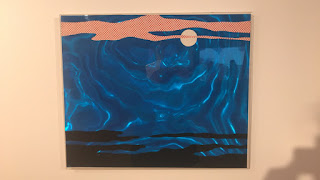The Carlton, 1981
Content:
I would describe this piece as bold, unique and colourful. The piece is an abstract room divider by Ettore Sottsass. The subject of this piece is imagined, as it is very different to any other furniture from the time and is specifically produced within the Memphis movement. I think that Sottsass has tried to break away from the common idea of 'good taste' and create a more decorative piece of furniture rather than purely functional. Sottsass' room divider is very abstracted and exaggerated, this gives the effect of how times are changing and that furniture doesn't have to be totally functional.
Formal Elements:
Sottsass has used graphic shapes and bright bold colours in the room divider. The way the piece is designed and arranged takes away functionality from the furniture and makes it more about the appearance and change in fashion. It has a bright colour scheme of primary and secondary colours throughout. The piece is also a build up of contrasts, as the colours and shapes throughout are all contrasting against each other to create a very bold statement piece. The lighting in this picture of the piece is central and from above, this makes sure you can clearly see the composition and colours in the room divider. All the colours have an equal significance in this piece as it is meant to be bold and contain many colours as it's from the 1980s and around this time the colours and disco was around. This meant that this was the right time for a piece like this, the start of change. There are recurring shapes throughout, in the angled shelves, because its a very graphic style and symmetrical.
Process:
The room divider is made up of wood with coloured plastic laminate covered on it, this makes it all the same texture. Sottsass would have started with the wooden pieces, covered them in coloured plastic laminate and stuck each piece together in a specific graphic pattern. This piece was made quickly as is was produced in a factory and mass produced. Sottsass clearly shows his design skills and skills with sculpture in this piece.
Mood/Meaning:
This piece evokes a happy mood as the colours are very bright and cheerful, like the time period of the 80s, and hows a clear influence by pop art and 1950's Kitsch. The purpose of Sottsass' piece is to break away from the rigid idea of furniture being made for function only and to be made of basic expensive materials e.g. leather, plain wood. It was imagined and created by himself and the Memphis group. It has a lasting impression as it was the start of something new at the time and is very different from what furniture would've been like before this. Sottsass conveys meaning through his piece, by using wood and plastic laminate to create it, as this shows that furniture can still be made cheaply and more decoratively than for just the function, yet be just as liked and appreciated eventually.
Influence:
It was a clear break in fashion and worked well with the introduction of disco, punk and fashion alike in the 80s. This piece is very unique and in my opinion, as a viewer, gives room to show how the fashions can change through time. At the time this piece impacted the way people saw furniture, however, because it was so drastically different some people were with it, others against it.
"You were either for it, or against it. "All the boring old designers hated it. The rest of us loved it," said Bill Moggridge, co-founder of the IDEO industrial design group.
Vico Magistretti said, "This furniture offers no possibility of development whatsoever," and "It is only a variant of fashion.“
To create and develop a piece inspired by Sottsass, we could take forward the bold colours and graphic designs and add them to different common items from the time now, this could be furniture, like the original pieces, or modern items such as phone cases or laptops etc.




























